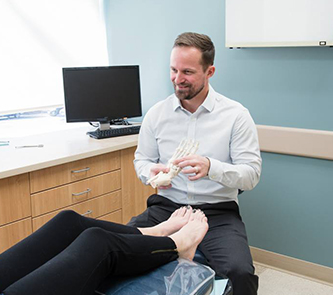6 Tips to Start a Running Program
Of course, that “health and wellbeing” extends beyond your physical body.
Sure, there are an abundance of physical benefits you receive when you exercise for at least 30 minutes 3-4 times a week. (Those are just recommended “minimum” guidelines, so don’t feel as if you have to cut your workout short after half an hour!)
Exercising burns calories, improves your cardiovascular system, reduces your risk for heart diseases, etc.
But you probably already know that.
Perhaps you also know that exercising improves your mood, lowers your risk for depression, helps you sleep better at night, and even contributes to enhanced mental processes. (All the extra oxygen and to the brain can really pay off!)
What you might not know—or at least haven’t actually thought about—is the fact that exercise is important for your feet.
And your feet enable you to have so many options in life.
When it comes to exercise, the most popular form in the world is one the human body is pretty much designed to do – running.
Interestingly enough, running also may have played an instrumental role in human development.
Some anthropologists believe our capacity for long-distance running was used by our ancestors in hunting, which led to a protein-rich diet that contributed to the development of the human brain as we know it today.
See, whereas there are many animals faster than humans are in short spurts, we have an endurance that far surpasses theirs. So early humans would chase an animal, which would sprint away. While the animal was resting from the sprint, humans continued to run. As they approached, the animal would have to interrupt its rest to sprint again. And this would continue until the hunters won.
Running is connected to our inherent nature.
That being said, we’ll bet you didn’t have to run down last night’s dinner, right?
As societies developed, running no longer became necessary for survival – but our bodies can still benefit from this activity.

If you’re an experienced runner, please feel free to keep reading if you would like. The tips and advice we are about to give are ones you hopefully already know and practice. But perhaps you will learn something new that can protect you from injury.
For new or going-to-be-new runners, we’ve compiled the following tips and advice so you can participate in this wonderful activity with the minimal amount of injury risk.
At this point, we have to make something clear – it is virtually impossible to completely remove the risk of injury from any physical activity. A human body in motion is one that can possibly become hurt. In other words, accidents happen. Even when using the best possible measures, you still could potentially sprain an ankle if your foot gets caught up on something along a running trail.
Besides doing your best possible job of paying attention to the running surface at all times—which then leads to the possibility of running into something because you aren’t watching where your going—there’s not much you can do about it.
So please keep in mind that the goal is to reduce your injury risk – not eliminate it completely.
When you are starting a running program, some measures you need to take include:
1. Map Out Your Running Journey
We don’t mean to chart your course—although, it will be rather important to know where you’re going later!—but rather to start by establishing your personal goals and milestones for your running program.
Take the time to think about what you’d like to accomplish. Some want to run a marathon, while others aim to drop a certain number of pounds. Just know that any goal you set is a good one! (Don’t be discouraged if you have no interest in running 20 marathons a year like your sister does.)
Make your running goals SMART – Specific, Measurable, Attainable, Realistic, and Timely. Vague goals that cannot be measured don’t allow you to know if you’re making progress. You need to know exactly what you are setting out to achieve, be able to see the progress you make, and know it can be accomplished in a timely, realistic manner.
Use a logbook to not only mark your progress, but also record future milestones you can be excited to hit. Knowing that you’re coming up on your hundredth mile or have put in 15 hours running over the month will keep you motivated.
Keep the “realistic” part in mind and make sure that your plans and milestones don’t include trying to run a marathon after only two weeks!
When people try to do “too much, too soon,” it usually doesn’t end well. Instead, plan on building up your frequency, duration, and intensity in a gradual manner. Otherwise, you only increase your risk for burnout and injury (like plantar fasciitis, Achilles tendinitis, stress fractures, etc.).
2. Use the Right Equipment
The good news is that the equipment needed for running—shoes, socks, and clothing—is fairly minimal. That said, it’s difficult to overstate the importance of wearing appropriate running socks and shoes.
Keep in mind that a decent pair of running shoes—and you do need footwear that is, at the very least, “decent”—can run in the neighborhood of a hundred dollars. Some cost more, but you might not need to go much beyond that price point to find a good pair that is comfortable, fits properly, and provides adequate support and stability.
3. Sometimes You Need to Walk Before You Can Run
Instead of trying to hit the ground running (in a literal sense), you may need to start out with a mix of walking and running – and especially if you haven’t been active on a regular basis for some time.
Slowly ramping up is important for lowering your injury risk, but it also can be helpful in keeping you from becoming easily discouraged in the early stages of your running program.
Accordingly, an intelligent strategy is to start your first week by using a 4-minute walk/1-minute run interval and repeating it six times through to provide a solid 30-minute workout. Do this at least 3-4 times in your first week.
Over the course of the next couple of months, gradually decrease the amount of time you spend walking and increase the amount of time running—always keeping the total walk/run time at five minutes—until you are able to run for 30 minutes without needing to walk.
4. Always Warm-Up and Stretch First
Heading out for a run with “cold” muscles is a risky endeavor, one that makes it more likely you suffer an injury. Instead of jumping right into your run, take some time for 5-10 minutes of brisk walking or light jogging. Follow this warmup with dynamic stretches.
What do we mean by “dynamic” stretches? Well, you can think of the traditional variety (holding a stretch in place for 30 seconds) as being “static.” Dynamic ones incorporate controlled movements that allow muscles to prepare for the activity ahead of them.
5. Avoid Overtraining

One category of foot and ankle injuries that tends to be quite common are overuse injuries. These are the injuries that develop in response to repeated strain and cumulative force loads from high-impact activities, like running.
Proper footwear can help by absorbing some of the force and promoting good biomechanical processes while you run. Even better is to consider cross-training.
Cross-training is a matter of mixing up the activities you use for exercise. In this case, you might decide to run for three days of the week, and then swim on three of the other days. Or you run four times during the week and do yoga on the other two days ect.
By incorporating low-impact exercises into your exercise program, you reduce the amounts of force your feet and ankles have to endure. As an added bonus, this strategy can lead to better overall fitness levels!
6. Don’t Push Through Foot Pain!
If you start to experience any pain from running—no matter if it’s sharp and sporadic or dull and chronic—your body is sending you a message that something is wrong and needs to be addressed.
Depending on the condition, you might simply need to rest a bit – but the best move you can make is to come see us for a professional diagnosis.
We can evaluate the situation and determine what’s wrong. Naturally, we don’t just usher you out the door at that point and say, “Good luck!” Instead, we take the time to create a customized treatment plan to resolve the core issue.
If you remember, we mentioned earlier that our goal is to allow you to do the activities you want to do. This means we will provide the care you need to get back to your running program in the quickest possible amount of time.
For more information on running injuries, the services we provide, or any questions you might have—or to request your appointment with either our Portsmouth or Nashua offices—give us a call at (603) 431-6070. One of our team members will be happy to help.
Pay Your Bill
Make a payment online through our payment portal or Care Credit!
Portsmouth Office
14 Manchester Square, Suite 250
Portsmouth, NH 03801
Nashua Office
17 Riverside Street, Suite 205
Nashua, NH 03062
Website Hosted by SC Digital



